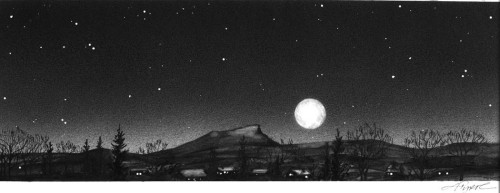
The coldest night of the year. It’s still too soon to know when it will occur this year, but whichever night it is, it’s almost certain to have three things going for it: it will be clear, with no wind, and at least some amount of snow on the ground.
That’s all because of something called radiational cooling, which is the most abstract of the three ways that things get cold. Convectional cooling – another of the three ways - is pretty straightforward: turn on the air conditioner and blow it in your face, open the freezer door and feel the draft, or stand outside on a windy day. The cold air moving past your face, quite literally, brings the cold to you, with the famous “wind chill factor” being a simple attempt to quantify just how quickly that cold is being delivered.
Conductional cooling, the third of the three ways of cooling something, occurs when there is direct contact between something warm and something cold. Think of sitting on metal bleachers watching a late-autumn sporting event or, more dramatically, using an outhouse in the winter. Putting ice on an injury to control swelling is another example of conductional cooling which, like convectional cooling, is pretty obvious to anyone who has ever stepped outside in winter.
But radiational cooling is less obvious. Nothing touches anything here, as it does with both conductional (butt to bleachers) and convectional (wind to face) cooling. Energy is simply drawn from something warm to something cold, with nothing but empty space in between. But even though you can’t put your finger on it exactly, radiational cooling is the chief reason why winter is so cold.
In the grand scheme of things, the earth is kept warm by radiational heating from the sun and kept from boiling over by radiational cooling out into deep space. There’s more heating than cooling by day and in the summer, and more cooling than heating at night and in the winter. So far so good.
But just as an awning shields you from the radiational heating of the sun in summer, so too can some sort of cover shield you from the radiational cooling of deep space in the winter. Our local deer and moose know this well – preferring to gather under the protection of conifers at night rather than out in the open. Conifer boughs are far warmer than the absolute zero of deep space and, even on the coldest of nights, reflect and radiate some heat back to the deer.
On a regional scale, nighttime clouds also shield the earth from radiational cooling, and the thicker the clouds, the less cooling takes place. That’s why the coldest night of the year will undoubtedly also feature bold, brilliant stars and a sharply etched Milky Way, with relatively little moisture in the atmosphere to dim the stars or insulate the earth.
Why the coldest night will also have no wind is somewhat less obvious, but think of swimming in a deep pond or lake in the summer: the deeper your toes go, the colder the water gets. The same is true when the air above us is still at night: the cold air sinks to the bottom (where we are) while the warm air rises. Though radiational cooling does its work on a windy, clear night, too, the overnight temperature will not be as low when the wind keeps the air mixed and prevents the coldest air from pooling at ground level.
Finally, the coldest night of the year is not likely to occur until after snow covers the ground. Bare ground absorbs heat from the sun during the day and then radiates it back out at night – an effect that, though not obvious on a bare-ground, 10-below night in late November, is nevertheless enough to prevent any temperature records from being set. Snow, meanwhile, both reflects most of the sun’s radiation during the day and insulates the ground at night, trapping the earth’s internal heat underneath, where it can’t affect the mercury reading.
Ironically, if you really want to feel cold this winter, don’t wait for a clear, windless night in the snowy hills of Vermont and New Hampshire. Go to the concrete canyons of a city. That’s not because of radiational cooling – the concrete typically absorbs some of the sun’s heat during the day and ends up being slightly warmer than the snowy woods back home. It’s because of a combination of convectional cooling – there’s always a stiff breeze blowing in Boston in the winter, isn’t there? – and something that ought to be described as the fourth way that things get cold in the winter: idiotical cooling, which happens when you leave your felt boots and wool hat back home.

